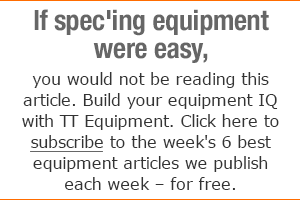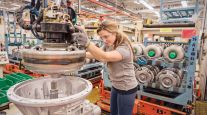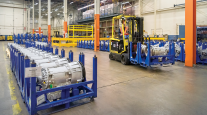More Vocational Fleets Opting for Automated Transmissions
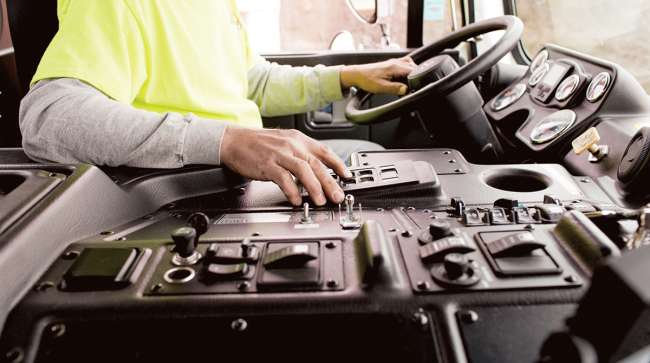
An aging driver population and the addition of vocational-specific features are the top reasons fleet managers and industry executives cited for growth in two-pedal transmission use among vocational truck buyers.
For both torque converter automatics and automated manual transmissions, executives cited drivability — that expansive term that has come to describe trucks that feel and handle like a car — as a big motivator helping to convert old die-hard, double-clutching gear shifters to these transmissions.
Further, today’s electronically controlled automatic and automated transmissions are offering application-specific features that appeal to construction companies, road pavers, cement mixers and other vocations with very specific needs, in which operators traditionally have believed that the job could only be done well by an experienced driver manually slugging through the gears.
Though they declined to provide specific numbers, every truck maker contacted said interest in automatics and automated manual transmissions, or AMTs, is growing among their vocational customers.
“The rise of two-pedal systems, whether it be Allison automatics or automated mechanical systems … are really continuing to increase,” said David Hillman, vice president of vocational marketing with International Trucks. “There are fans of each style.”
“Drivability” and reducing driver fatigue are among the bigger reasons for the change on the vocational side, said Alex Stuckey, heavy-duty product strategy manager for Eaton Cummins Automated Transmission Technologies, the joint venture of engine maker Cummins Inc. and transmission supplier Eaton Corp. “We’re seeing growth in the adoption rate; we continue to see that ratio escalate and we anticipate that to continue.”
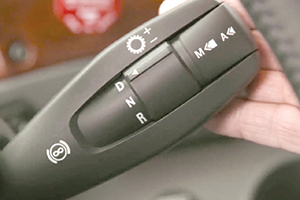
Driver controls for Detroit's D12 automated manual transmission (Daimler Trucks North America)
Freightliner’s vocational customers are spec’ing “a high percentage” of 114SD models with automatics or AMTs, said Kelly Gedert, director of product marketing for Freightliner and Detroit Components. The take rate for the larger 122SD model is lower but increasing.
Twenty-five years ago, Hillman said, the heavy vocational trucks were handled by drivers who prided themselves on their ability to handle a manual transmission in all sorts of situations; “real truckers,”as they might call themselves.
“While there is still a fan base like that, it’s diminishing over time,” Hillman said. “Some drivers are retiring and some, although they’d swear up and down they were a three-pedal guy, try [an automatic or AMT] and realize they don’t have to monkey around with the shifting. They can focus on the job at hand.”
Automatics and AMTs level the playing field when it comes to drivers, said Chad Brown, vice president of Brown Transportation, an aggregate hauler based in Ardmore, Okla. The company used to run 13-speed manuals, but the 80-truck fleet has been switching to automateds, in this case Eaton UltraShifts, as the fleet replaces its older equipment with new Kenworth trucks.
“Where one guy may go through a clutch at 200,000 miles, another will go a lot longer. With the [AMT] you don’t have to worry about that. The [AMT] never misses a shift. The fuel economy is consistent throughout the whole fleet. It just gives me much better control over the fleet,” Brown said.
But what do drivers say?
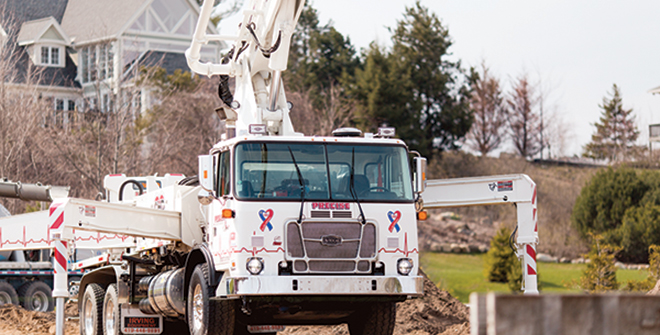
Pete Pawloski, owner-operator of Precise Concrete Pumping, ran an 8-speed manual transmission until his new truck, an Autocar Xpeditor with an Allison RDS (Autocar Trucks)
“Driver fatigue is considerably less,” said Pete Pawloski, owner and operator of the single-unit Precise Concrete Pumping, based in Traverse City, Mich. Pawloski used to run an 8-speed manual until his new truck, an Autocar Xpeditor with an Allison RDS.
“Once you go to an automatic, you realize how many times you’re pressing that left foot pedal and double clutching,” Pawloski said. “Your right shoulder begins to feel a little better. Another perk is safety. When I had the manual, there were a couple of certain intersections I would avoid because by the time you shift into second, you’ve already lost all forward momentum.”
But drivability has been a selling point for automatics and AMTs for years in linehaul and nonvocational applications. What’s new is that advancements in low-end gearing, onboard technology, data gathering and fuel-economy features are making these transmissions more attractive for pavers, contractors and other vocational users, suppliers said.
Freightliner’s Gedert said more vocational transmissions are going out with power take-off mounting and crawler gears. Those transmission choices and shift schedules were maximized for startability, gradeability and requested cruise speed, among other specs.
The 14-speed version of Volvo’s I-Shift with crawler gears can be spec’d for use in applications up to 220,000 pounds gross combination weight and operate as low as 0.6 mph, said John Felder, product marketing manager for vocational trucks at Volvo Trucks North America.
“That makes it ideal for paving,” he said. “We’ve also added Paver Assist for the I-Shift on Volvo VHD dump trucks to help eliminate bumps and disturbances in the pavement-laying process that traditionally occur while shifting from neutral to drive.”
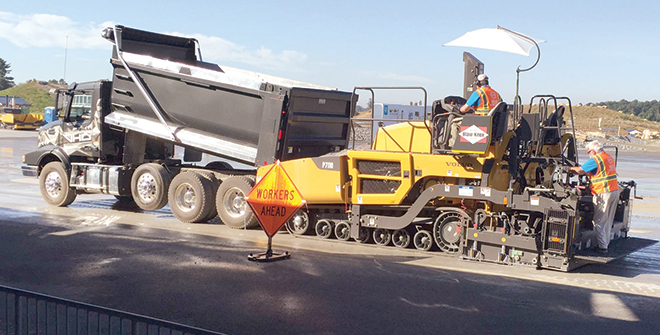
Volvo Trucks has added a "paver assist" feature for its I-Shift transmissions on Volvo VHD dump trucks for smoother operation during the pavement-laying process (Volvo Trucks)
“A full automatic can provide a very high level of torque at low vehicle speed,” said Adam Burck, vice president of brand management with GVW Group, parent company of vocational truck maker Autocar. “On a construction work site, you’re using a very heavy vehicle, often in a slippery, unstable situation. It’s very hard for most drivers to move 100,000 pounds in sand. You can quickly dig the vehicle into soft ground. Also, all sorts of wheel hops and slips can lead to severe damage to driveline components and axle shaft failures.”
Autocar offers automatic Allison transmissions in all of its trucks.
Eaton Cummins’ Stuckey also said automated transmissions can provide durability advantages.
“There are more opportunities to abuse a manual product,” Stuckey said. “We’ve done a lot [with AMTs] to protect the driveline and prevent damage through software. We’ve been working with engine platforms to develop calibrations paired with an engine’s torque curve to optimize performance.”
Eaton’s 10/11-speed UltraShift Plus VCS/VMS (construction/multipurpose series) transmission offers extended low and reverse gear ratios, providing “the lowest ground speed for curbing, creeping, spreading and paving,” according to the company.
Dave Jackson, co-owner of Redbank Transport Inc., a regional construction-materials hauler based in Milford, Ohio, likes the opportunity to have automatic and manual modes available. His drivers can forgo shifting when on the road, but they also have the option of shifting to manual mode for better control once they hit the job site.
“When you pull into the job site, I tell [drivers] to put it into manual. You take control of the tranny and do what you want to do on that job site. You don’t want the tranny to guess,” he said.
Also, having the AMTs means Jackson doesn’t have to teach new drivers how to shift. “Most of my [pre-employment] test driving now is to see how he handles a truck,” Jackson said.
The data-gathering capability of today’s electronically controlled transmissions gives fleet managers insights into the transmission’s health and the driver’s skills, additional features Jackson said he appreciated.
“I can also do things as a company to control my drivers. I can have them all shift at certain rpm. [The transmissions] have performance modes and economy modes that I can change from one driver to the next. I can do all that tweaking in house. It’s amazing what all we can do now with this,” Jackson said.
The good news for vocational truckers is that the electronic capabilities and operational features of these transmissions will continue to develop.
“Improved sensors and actuators, along with integrated chip density with sophisticated system software allows fast control loops and opens the door for further expansion of features so that there’s an AMT rated for any Class 8 vocational truck application,” Volvo’s Felder said.
Customers can expect to see greater use of remote diagnostics, advanced prognostics, predictive maintenance and over-the-air programming, among other features, as systems develop, Freightliner’s Gedert said.
For some applications, weight will influence the spec’ing decision. A fully automatic transmission with its torque converter and cooler can weigh several hundred pounds more than an automated manual, depending on the configuration.
The listed weight of the Allison 4700 RDS 7-speed automatic, for example, ranges from 1,087 pounds for the basic version to 1,224 pounds with the power take-off and retarder.
The Eaton Fuller Advantage automated 10-speed weighs in at 850 pounds, while the UltraShift Plus VPS/VPM 10/11-speed AMT for the vocational market is listed at a maximum of 978 pounds.
Of course, if weight really does matter, the 10-speed manual Eaton Advantage weighs 541 pounds, 309 pounds less than the AMT version.
Given that vocational trucks represent a comparatively small size of the heavy-duty market — less than 6% of new Class 8 vehicle registrations in 2017, according to IHS Markit — it may be understandable that it has taken a while for two-pedal transmissions to make notable inroads into the sector. But if the current demographic trends continue, more vocational fleets and drivers are going to be demanding that car-like drivability that automatics and AMTs offer.


